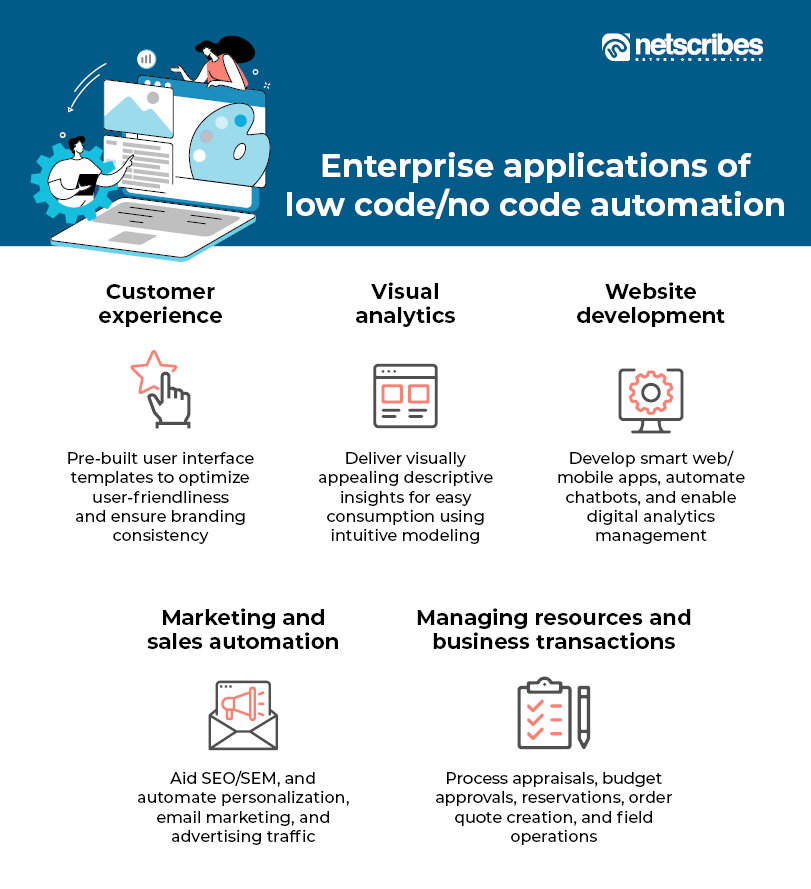Great Advice To Picking Low-code platforms for application development
Wiki Article
Speed-WiseLow-Code Software Offers A Variety Of Advantages.
Visual Development Environment (VDE):
Drag-and-Drop Interfaces: Low-code platforms provide visual tools for designing applications. Developers can utilize drag-and-drop tools to create applications quickly and without writing a large amount of code.
Templates and components that have been pre-built Numerous platforms that can allow low-code support come with templates and components that are pre-built which allow developers to create prototypes quickly and create applications without needing to start entirely from the beginning.
Reduced Coding Requirements:
Automated Code Generation: The low-code platform generates the code beneath based on visual models created by developers. This removes the need to write code manually and accelerates the process of development.
Reusable Parts: Developers will be able reuse reusable components across different projects, and cut down on the time needed for writing and testing code.
Collaboration can be made easier.
Low-code platforms have a myriad of tools to facilitate seamless collaboration between teams working on development. They include version control, testing and deployment.
Citizen Development (Citizen Development) Developers and users of business applications can take part in application development using user-friendly interfaces. This helps to reduce the bottleneck created by limited professional developer availability.
Rapid prototyping, rapid iteration and rapid prototyping
Rapid Prototyping. Developers can create prototypes quickly to validate their ideas as well as get feedback. This will lead to a quicker iteration process.
Easy Modifications: The visual nature of low-code development makes it simpler to make modifications and updates to applications. This speeds up the process of improving and refining applications based on feedback from users.
Pre-built Integrations:
API Integrations: Platforms that are low-code often have pre-built connectors for well-known APIs and services, reducing the time required to connect external systems.
Data Integration: Inbuilt software for data integration simplify the process of connecting databases and other sources of information and speeding development.
Deployment Scaling
A lot of low-code platforms offer one-click options for deployment which can reduce the time and effort required to set up applications.
Cloud-based solutions: Cloud platforms with low-code enable developers to focus on the logic and functionality of their apps instead of worrying about deployment logistics.
The primary benefit of low code application development in terms of speed, is its capacity to automatize and simplify many aspects of the process. This enables faster delivery of applications, and faster adaptations to evolving requirements. Read the top Low-code Platform for application development advice for more tips including cross platform mobile app development, low code development platforms, develop web app, push alerts, push notifications, multiplatform mobile app development, develop mobile application, app platforms, app development platform, application modernization software and more.

Low-Code Software Is Cost-Effective.
Low-code development can bring many benefits in terms of cost effectiveness. This makes it an ideal choice for companies looking to reduce their development budgets, while still providing top quality software. Here are a few of the most important advantages:
The low-code platform eliminates the need for lengthy manual coding. This means less time and effort on the part of developers in developing applications. This results in lower labor costs.
A smaller number of developers: Since low-code development is quicker and simpler and less complex, there are fewer resources for developers required. This will drastically lower costs of staffing and hiring.
Time to market faster:
Accelerated Development: Low-code platforms provide visual development tools, pre-built components and other tools that allow rapid development of applications. Companies can launch their products on the market more quickly. This can lead faster revenue growth and improve the competitive position of their products.
Rapid Prototyping. By rapidly creating and testing prototypes, businesses can speed up development and improve their product faster based on user feedback.
Low Maintenance Costs
Because of their modularity and standard components, apps built on low-code platforms are easier to maintain. This reduces the ongoing maintenance and support cost.
Automated Updates. Many low-code platforms manage updates and patch automatically. Applications remain safe without requiring a lot of manual input.
Efficient Resource Utilization:
Non-Developer contributions: Low code platforms allow non-developers, like business users, to participate in the process of development. This decentralization of the development process permits companies to tap into the expertise and talents of a wider variety of employees.
Optimized Use Of IT Resources IT teams can focus on strategic initiatives rather than getting bogged down with mundane development work, improving the efficiency of their teams and productivity overall.
Scalable Pricing Models
Subscription-Based Pricing: Many low-code platforms offer flexible, subscription-based pricing that can scale in line with the amount of use. This allows businesses to alter their budgets according to their needs and growth without having to pay large initial cost.
Pay-as-you-go options - Some platforms allow businesses to pay only for the services they use. This is particularly useful for small or start-up companies with limited funds.
Reduction of Third-Party Costs for Software:
Built-in Functionalities: Low code platforms have a variety of integrated features and integrations which eliminate the need for third-party tools and software. The cost of subscriptions and licensing costs are also cut down.
Pre-Built Integrations: The existence of pre-built integrations with popular systems and services reduces the requirement for custom development, thereby saving time and money.
Increased ROI:
Increased ROI: Businesses will achieve a higher ROI on their applications by combining rapid development, less expensive and a faster times to market.
Increased Agility: Businesses are able to quickly adapt to changes in market and the changing needs of customers. This lets them stay relevant and to take advantage of opportunities that come up.
Lower Training Costs:
User-Friendly interfaces: Low-code platforms have intuitive and user friendly interfaces that cut down on the time required to learn. They also minimize the requirement for long-running courses of instruction.
Accessible resources A lot of low-code platforms offer comprehensive tutorials, training materials, as well as community support, reducing the requirement for formal training.
Collaboration is made easier:
Enhanced Collaboration Tools : The collaboration tools that are built into the software aid in communication and coordination between the team members. This leads to a more efficient project development process as well as lower costs.
Unified Development Environment : A unified environment makes work easier and cuts down on the expenses that are associated with managing different platforms and tools.
The efficiency of low-code application development comes from its ability reduce development and maintainance costs, speed up time to market, optimize resources, and also offer different pricing options. These factors deliver significant financial benefits to business, making low code an attractive option for businesses looking to maximize their budgets and create solid, reliable, high-quality applications. Have a look at the top rated https://www.wavemaker.com/application-modernization/ for blog examples including develop web app, software for app development, app modernisation, application modernization software, mobile app development platforms, build a docker container, app platforms, cross platform mobile app development, cross platform mobile app development, cross platform mobile development and more.

Benefits Of Low-Code Application Development In Terms Of Community Support And Vendor Support
Low-code platform development has many advantages, such as vendor support and community support. This is vital for ensuring the success of application implementation as well as ongoing maintenance and constant improvement. Here are some key advantages.
Comprehensive Technical Support:
Support Teams: Many Low-Code platforms provide access to a dedicated support team that can help with technical issues, advice and troubleshooting.
24/7 Support Some suppliers are available around the clock This is useful for companies operating in different time zones.
Onboarding and Training:
Vendors typically offer organized programs for users like tutorials and webinars. They might also offer certification courses.
Personalized Onboarding: A lot of vendors provide personalized onboarding services to help new customers implement the platform in a way that is effective and customize it to their particular requirements.
Updates and regular updates:
Continuous Improvement: Low-code platform vendors release regular updates, which include new security patches, features and improvements to performance. This makes sure that the platform remains updated and safe.
Feedback Integration Vendors incorporate customer feedback into the development cycle to ensure that the platform evolves to meet changing needs.
Comprehensive Documentation:
Documentation: Detailed documentation is provided for the majority of products. It covers everything from the basics to the most advanced customisation. It helps users locate solutions on their own.
API References API documentation can help developers customize and integrate applications using the Low-Code platform.
Consultancy and Professional Services
Expert Consulting. Vendors provide a variety of consulting services including the design of architecture along with strategic planning and platform implementations. They ensure that customers are able to maximize the benefits of their platform.
Custom Development Services Certain vendors offer custom development services in order to build specific functions and integrations that are not included in standard.
Community Support for the Community
Active User Communities
Discussion and Forums: Many low-code platforms have vibrant online communities, which allow users to ask questions, discuss strategies, and even collaborate with each other on best methods.
User Groups and Meetups: Virtual and local user groups and meetups are great to meet, network and sharing your experiences with other users.
Collaboration and Knowledge Sharing
Community-Contributed Resources: Users often share templates, modules, and extensions that they have developed, which can be reused or adapted by others, accelerating development and innovation.
Crowdsourced Problem-Solving: The collective wisdom and experience of a group can be a valuable help to resolve issues and discover creative solutions to complex problems.
Learning and Development
Community-Led training: Many communities provide webinars, workshops, and training sessions facilitated by knowledgeable users.
Online Tutorials and Courses: Users of the community often share and create online tutorials, courses, and instructions on how to accomplish things that enhance learning resources.
Feedback and Influence
Forums for Product Feedback Community forums contain a number of channels for giving feedback to vendors, which can influence the design of features.
Beta Testing Programmes: Community members who are active get the chance to take part in beta-testing programs. It gives them an early glimpse of new features as well as an opportunity to contribute to the future of the platform.
Recognition and encouragement:
Community Recognition Programmes: Many companies offer recognition programs to active community members. Some examples include MVP (Most Valuable Professionals) which acknowledges their contribution of community members.
Peer Support: Community members typically provide peer support, sharing their expertise and providing advice to users who are not as familiar creating a more collaborative and positive environment.
In general, the combination between strong vendor support and active, engaged communities, provides a comprehensive ecosystem of support for low-code development. Users will have the expertise and resources they need to build and deploy their application.
